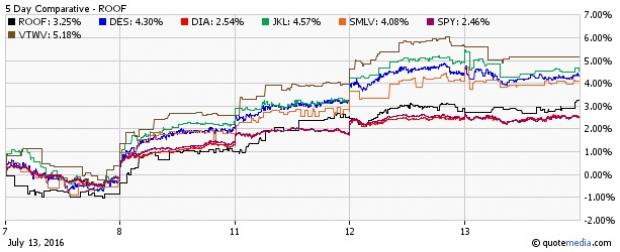Key U.S. stock indices including the S&P 500 and Dow Industrials hit consecutive highs this week, giving hints that the risk appetite is back on the market. Not only the large-cap U.S. indices, the major global markets celebrated this new-found optimism over equities.
But have you taken a note of small-cap indices? How these are performing and if they have a greater scope of capital appreciation going forward than the larger ones? If not, we tell you why.
Drivers of Rally Mainly U.S.-Centric
Definitely the positivity was prompted by the post Brexit rally, Shinzo Abe’s recent election win that gave cues of hefty government stimulus in Japan, oil price gains and hopes of more policy easing from the other key central banks including the Bank of England.
But what mattered most for the recent rally was a recovering U.S. economy as evident from the strong job data for the month of June and a 16-month high manufacturing data. Investors welcomed these as many were of the view that U.S. economy had lost steam and thus pulled out their money from the market and parked it in safe havens.
In fact, the June job data – following a shockingly downbeat May – was much-eyed and the success of it brought real joy to the market July 8 onward (read: ETFs to Buy After Strong Jobs Report).
Now since small cap stocks are more closely tied to the domestic economy, such upbeat data points call for investing in smaller-caps now.
Delayed Fed Rate Hike
The Fed is expected to remain dovish in the coming months, waiting to watch the Brexit fallout and seeking more stabilization in the U.S. economy. This ensures cheap money inflows in the days ahead, and could be the key to the success of small-caps (see all Small Cap ETFs here).
Small-Cap Indices Yet to Hit Highs: More Upside Potential?
The common investing mantra is not to chase current highs but to tap those which are likely to hit highs. With the S&P 500 and the Dow Jones already testing all-time highs, further upside potential in these is limited.
Agreed, there are analysts like B.of A. Merrill Lynch, who believe “now is the time for investors to buy high, so they could sell higher” and that the S&P 500 is likely to surge past 2,400 in a year. But the fact that there are plenty of downside risks can’t be ignored. The Fed is also concerned about U.S. equities’ overvaluation. Several analysts including Goldman is not too optimistic on stocks.
No matter how the broader market behaves, risks loom large from every aspect, be it the S&P 500 earnings recession/slowdown, presidential election in November or the concrete impact of Brexit on the global economy.
On the other hand, small-cap index Russell 2000 added over 2.4% in the last two days (as of July 12, 2016), but is still down 5.5% from the 52-week high. As a result, the upside potential from here is higher for small caps.
Investors should also note that even if the S&P 500 hit record highs this week, the index gained over just 1% in the last two days (as of July 12, 2016), indicating lower capital gains than Russell 2000 (see all small-cap ETFs here).
Small-Cap ETFs with a Dividend Focus: Great Picks
So, gutsy investors can wash their hands of large-cap stocks at the current level and take the small-cap ETF route to play the potential U.S. growth and a late as well as sluggish rate hike.
Also, with the U.S. benchmark Treasury yields hovering around extremely low levels and falling below 1.50% on July 13, 2016, a look at small-cap ETFs with 2% or more dividend yield seems warranted (read: Small-Cap Value ETFs: The Right Play Now?).
IQ US Real Estate Small Cap ETF ROOF)
This small-cap real estate ETF yields over 5% annually. Also, investors should note that real-estate ETFs are rate-sensitive and perform well in a low-rate environment.
SPDR Russell 2000 Low Volatility ETF SMLV
The fund delivers exposure to low volatility by investing in small-cap equity securities. It yields about 2.87% annually (read: Fear Volatility in Small Caps? Try These Low Volatility ETFs).
WisdomTree SmallCap Dividend Fund DES
DES looks to track the performance of the small-capitalization segment of the U.S. dividend-paying market. DES yields about 2.84% annually.
Vanguard Russell 2000 Value ETF VTWV
This fund gives exposure to small-cap value stocks which that can weather stock market downturns to a large extent. The fund yields 2.47% annually.
iShares Morningstar Small-Cap Value ETF (AX:JKL)
This is yet another small-cap value focused ETF yielding about 2.44%.
Bottom Line
Investors should also note that the returns of afore-mentioned ETFs beat the S&P 500-based (AX:SPY) and Dow Jones-based SPDR Dow Jones Industrial Average ETF Trust ( (V:DIA) in the last five-day trading sessions (as of July 13, 2016).

SPDR-DJ IND AVG (DIA): ETF Research Reports
SPDR-SP 500 TR (SPY (NYSE:SPY)): ETF Research Reports
WISDMTR-SC DIV (DES): ETF Research Reports
ISHARS-MO SC VL (JKL): ETF Research Reports
SPDR-R2000 LV (SMLV): ETF Research Reports
IQ-US RE SC (ROOF): ETF Research Reports
VANGD-RUS 2000V (VTWV): ETF Research Reports
Original post
Zacks Investment Research
